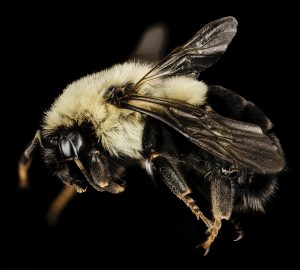Tamra Reall
Whizz! “What was that?” my son exclaimed as a tiny, fuzzy object shot past his head, much like a minuscule, fluffy guided missile headed to a hole near my home’s foundation. We looked closer and soon another mostly black with a golden thorax (plus a yellow abdominal stripe) bumble bee emerged and with the same focused determination, left the nest to find more pollen for provisioning her nest. While a commonly encountered bumble bee throughout much of North America, we felt privileged to have this Bombus impatiens (common eastern bumble bee) family make their home next to ours where we could watch them all season long.
Perhaps this thriving colony was related to the bumble bee queen I encountered the previous spring as I set up my new pandemic garden in my backyard. As I cleared the leaf litter to set up a raised bed garden, I noticed an unusually large (1 inch) bumble bee climb onto my lumber, stretching her legs and greeting the day after a long Winter’s slumber. As I drew closer to welcome this beneficial pollinator, she lifted a midleg as if to greet me! (See it here: https://bit.ly/BimpatiensWave.) It turns out that this “greeting” is actually a warning – stay back! Note to future self: bumble bee stings don’t hurt as bad as honey bee stings initially, but the dull pain lasts longer. Fortunately, no bumble bees were harmed in the making of this story because they don’t have barbed stingers and this new Spring queen safely flew away.
New colonies of B. impatiens start with a young queen, called a gyne, who leaves her nest in the Fall. She mates with a single drone and then excavates a small, underground chamber to hibernate through the cold Winter months. Upon emerging in early Spring, she forages for nectar and seeks a suitable nesting site – an abandoned underground burrow left by a small mammal. She creates a honeypot near the nest entrance and fills it with nectar. She also deposits a lump of nectar-moistened pollen for easy access as she begins to lay eggs in cells, singly or many per cell, clustered throughout the nest. She will tend to the first round of brood until they can forage and tend to future offspring – a process of about four to five weeks. Worker bees vary in size, from ⅓ to ⅔ of an inch, depending on food availability. Yellow-faced drones are produced towards the end of the season and leave soon after emerging as an adult.
Foragers use a strategy called traplining – efficiently visiting food sources in a repeatable sequence regarding location and time of day. While they don’t waggle dance, they communicate good sources of food with nestmates. Like honey bees, they create honey although not in harvestable amounts.
Many colonies never reach the end of the season, unfortunately. Surprisingly, then, is that these bees are highly adaptable, nesting in urban, agricultural, wetland, and wooded habitats. In addition, they are “domesticated” for greenhouse pollination, which led to this species spreading further than their original distribution.
As seed catalogs arrive and I design my next garden, I’m adding some extra lavender, salvia, and impatiens – the flower for which this bumble bee may be named. B. impatiens also like asters, clover, goldenrod, and buttonbush, as well as many flowers of garden fruits and vegetables. I will know Spring has arrived when the queen greets me and the workers start flying, full of purpose and without regard to their admiring human audience.
Dr. Bug (aka Dr. Tamra Reall) is a horticulture specialist for the University of Missouri Extension. A former beekeeper and always a bee admirer, she seeks opportunities to share the beneficial aspects of these fascinating animals. To contact Dr. Bug, send emails to BugNGarden@gmail.com.












